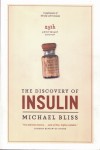The Discovery of Insulin by Michale Bliss (2007. University of Chicago Press. Eli Lilly 25th Anniversary Edition. ISBN 978-0-226-05899-3)
Normally, I don’t read medical literature. But, when researching a character who’s afflicted with a particular malady, an author needs authenticity. In those situations, authors (including this author) read medical literature.
In the case of the female protagonist in my novel-in-progress, Sukulaiset: The Kindred, the condition Elin Goldfarb battles (in addition to Communists and Nazis) is diabetes: a disease of the pancreas that affects millions of Americans. Type I, or insulin dependent diabetes, is the condition that Elin must deal with as she wanders through Depression-era Karelia and WW II-era Finland and Estonia. So in dealing with the character, in trying to make her situation as real as possible in a work of fiction, I asked a friend’s wife, Dr. Jen McVean, a medical doctor and a specialist in childhood diabetes, where I could find historical information on the disease. She pointed to Bliss’s book as the place to start.
The Discovery of Insulin depicts the work of four Canadian researchers/physicians during the early 1920s. Dr. Frederick Grant Banting, an ordinary surgeon, hit upon the idea that the pancreas contained certain enzymes that might be of benefit in the treating of diabetes. He was not the first person of scientific background to claim this hypothesis but, after presenting it to Professor John Macleod at the University of Toronto, Banting was allowed to conduct some experimental surgical work on dogs. He was given one assistant: Charles Best, a medical student. Another researcher, Dr. James Collip, eventually joined the team. Though there was much rancor and dissension between the four men (mostly caused by Banting’s incessant drinking and fragile ego as depicted by Bliss), eventually, the research isolated insulin as a compound worthy of testing on human beings in the last stages of the dreaded disease. The cures that were achieved once the team got the “bugs” out of their concoction were remarkable. Young men and women were brought back from the brink of diabetic comas to life. Living skeletons starving on diabetic diets regained good health and went on to live relatively ordinary lives on insulin injections (with Eli Lilly being the first commercial manufacturer of the compound). By the mid-1920s, the time frame for the beginning of my novel, the drug was available worldwide and diabetics were no longer destined for long, excruciatingly painful deaths due to their bodies’ inability to metabolize food.
In a controversial move, the Canadian government awarded Banting the lion’s share of recognition for his work (even though later analysis proves his original idea (“The Idea”, in Banting’s own words) was a based upon a false premise) which, of course, soured the other three men towards Banting. Adding insult to injury (to Best and Collip), Banting and Macleod shared the 1923 Nobel Prize for Science, the only Canadians to do so.
The book added immensely to my knowledge regarding the pathology of diabetes and the discovery of insulin as a treatment for the disease. However, Bliss’s work does bog down in repetitive descriptions of Banting’s and Best’s experiments on dogs (many of whom died during the research). It is when Bliss concentrates on the human interactions between the researchers and their human failings that the book holds a layman’s interest.
3 stars out of 5.



